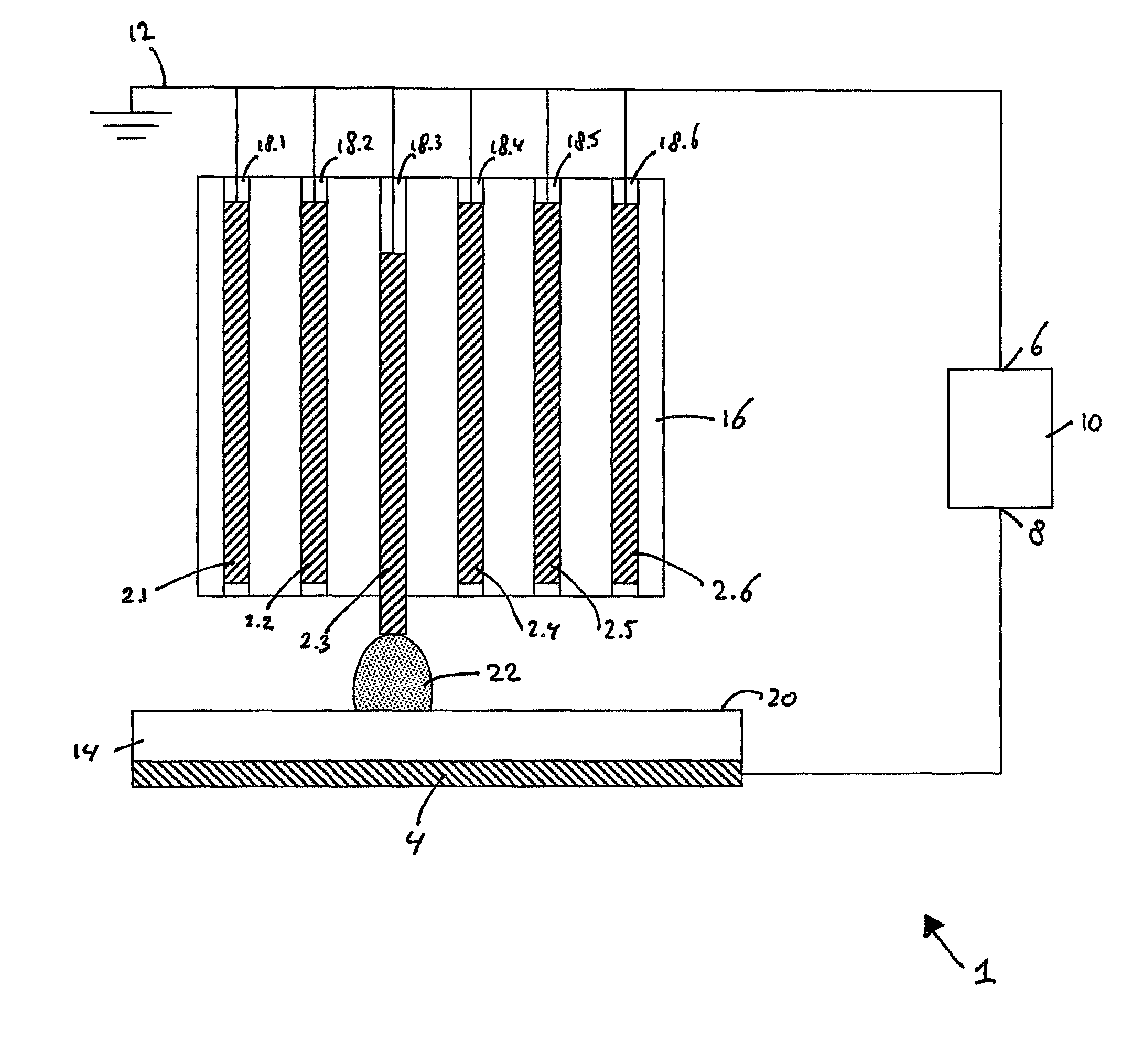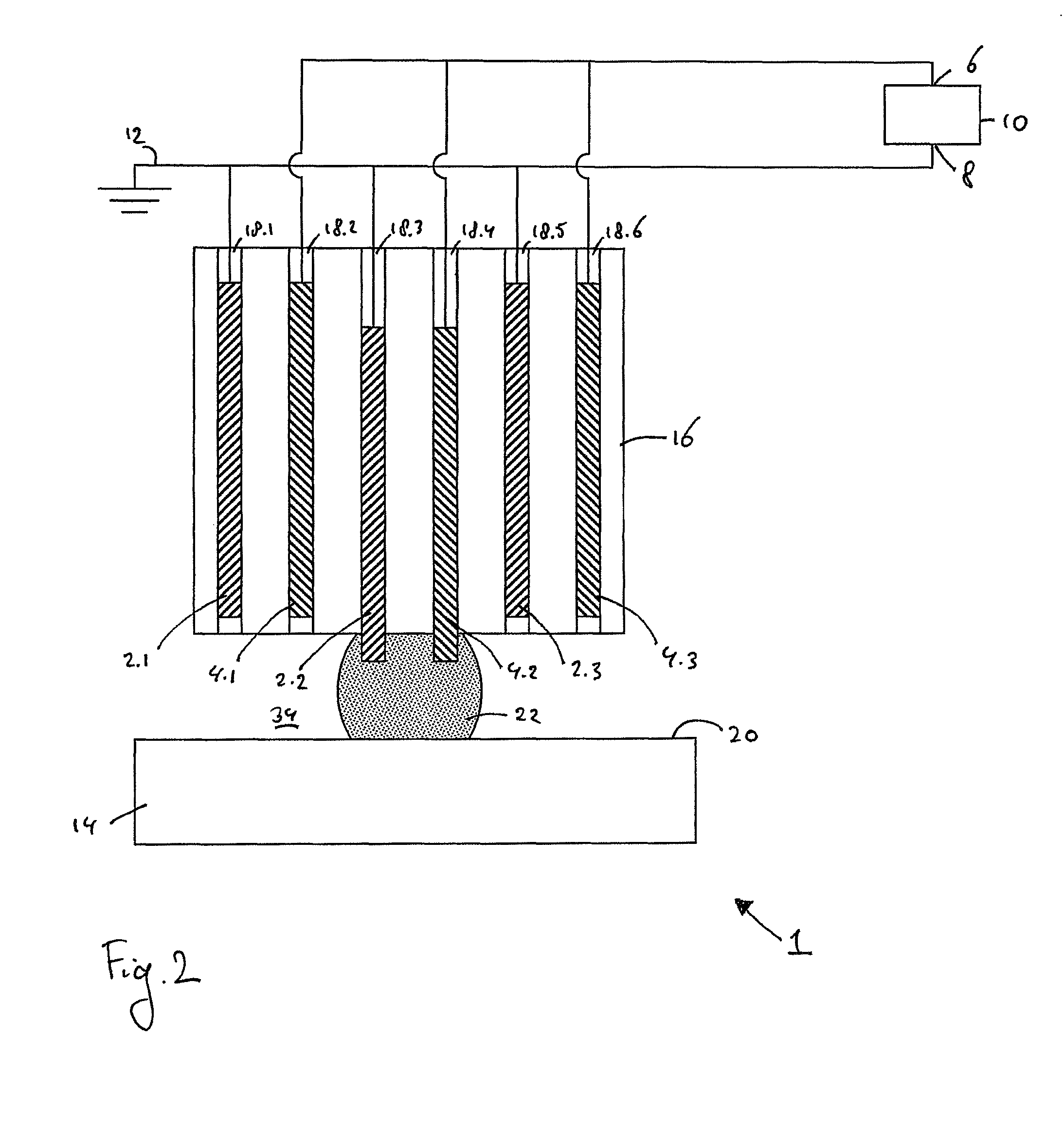Device for generating a plasma discharge for patterning the surface of a substrate
a technology of plasma discharge and substrate, which is applied in the field of generating a plasma discharge for patterning the surface of a substrate, can solve the problems of complicated high voltage pulse control, high cost of mask, and use of thin substrates, etc., and achieves fast patterning of substrates, simple control, and long electrode life
- Summary
- Abstract
- Description
- Claims
- Application Information
AI Technical Summary
Benefits of technology
Problems solved by technology
Method used
Image
Examples
first embodiment
[0034]FIG. 1 shows a schematic representation of a device 1 for generating a plasma discharge for patterning the surface of a substrate according to the invention.
[0035]In this example, the device 1 comprises a plurality of first electrodes 2.i (i=1, 2, 3, . . . ). In this example, the first electrodes 2.i are designed as elongate pens. The device 1 further comprises a second electrode 4. In this example, the second electrode is plate-shaped. The first and second electrodes 2.i, 4 are electrically conducting connected to terminals 6,8 of a high voltage source 10 respectively. The high voltage source 10 is arranged for generating a high voltage difference between the first electrodes 2.i and the second electrode 4. In this example, the first electrodes 2.i are also connected to ground at 12. It will be appreciated that the first electrodes may be negatively charged with respect to the second electrode or vice versa, e.g. depending on whether ions or electrons are desired to impact on...
second embodiment
[0047]FIG. 2 shows a schematic representation of a device 1 according to the invention. In this example, the plurality of first electrodes 2.i and a plurality of second electrodes 4.j (j=1, 2, 3, . . . ) are positioned side-by-side. In this example both the first and second electrodes are slidably housed in their respective bores 18.k (k=1, 2, 3, . . . ).
[0048]The device 1 as shown in FIG. 2 may be operated in the following manner.
[0049]The substrate 14 is placed near the first and second electrodes, 2.i, 4.j. The high voltage difference is set and maintained between the first and second electrodes.
[0050]When the surface 20 of the substrate 14 is to be selectively treated with a plasma, the location where the surface 20 is to be treated is determined. The first electrode 2.i and the second electrode 4.j closest to the determined location on the surface are selected. In this example, first electrode 2.2 and second electrode 4.2 are selected.
[0051]Initially all first electrodes 2.i an...
sixth embodiment
[0079]FIG. 6 shows a device 1 according to the invention. In this embodiment a conventional inkjet print head 35 is converted for the purpose of providing the plasma discharge. In this example, the inkjet print head comprises a plurality of nozzles 37.n (n=1, 2, 3, . . . ). Per nozzle, two piezo-electric elements 36,38 are positioned adjacent an internal ink chamber 40. According to the modification, the piezo-electric elements 36,38 are electrically conducting connected to the terminals 6,8 of the high voltage source 10, respectively. When a high voltage difference is maintained between the piezo-electric elements 36,38, these act as the first and second electrodes 2.i, 4.j.
[0080]The device of FIG. 6 may be operated as follows. Instead of an ink, a gas flow is fed into the print head 35, as indicated with arrow G. When the surface 20 of the substrate 14 is to be selectively treated with a plasma, the location where the surface 20 is to be treated is determined. The nozzle 37.n and...
PUM
| Property | Measurement | Unit |
|---|---|---|
| voltage | aaaaa | aaaaa |
| electrical conducting | aaaaa | aaaaa |
| three dimensional structure | aaaaa | aaaaa |
Abstract
Description
Claims
Application Information
 Login to View More
Login to View More - R&D
- Intellectual Property
- Life Sciences
- Materials
- Tech Scout
- Unparalleled Data Quality
- Higher Quality Content
- 60% Fewer Hallucinations
Browse by: Latest US Patents, China's latest patents, Technical Efficacy Thesaurus, Application Domain, Technology Topic, Popular Technical Reports.
© 2025 PatSnap. All rights reserved.Legal|Privacy policy|Modern Slavery Act Transparency Statement|Sitemap|About US| Contact US: help@patsnap.com



